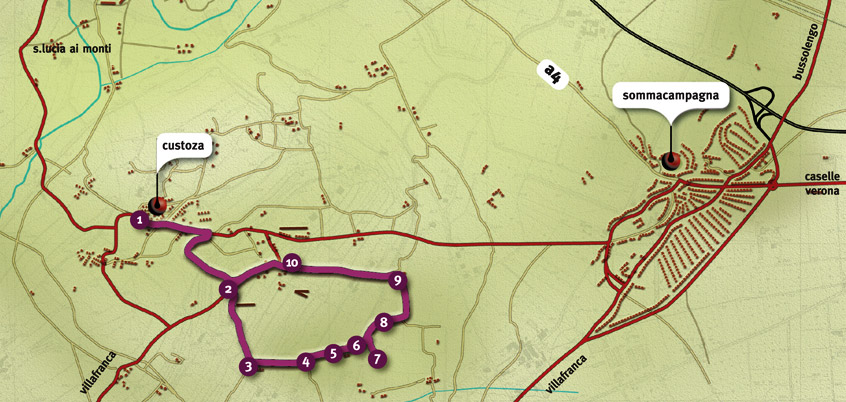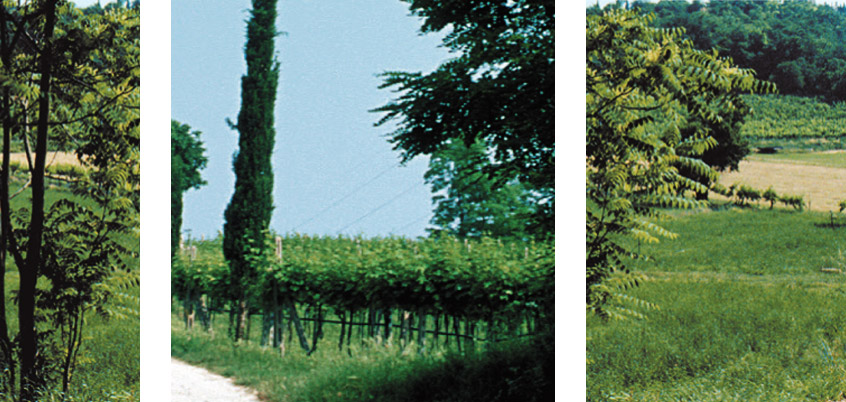TAMBURINO SARDO PATH – THROUGH HISTORY AND NATURE

Tamburino Sardo is an easy practicability path, which extends for about 3 km on the plain part, part hillside, following the ridge of Monte Croce (153 meters high).
Absorbed in the countryside, the course allows you to admire a landscape characterized by extensive cultivation of vines pergola and interesting environmental values, which are spread whispers of that story of renaissance that has made these lands famous, theatre of bloody battles for independence and the ‘unity of Italy.
1.
Our journey starts from the square of the church of San Pietro in Vinculis. You walk in the direction of Sommacampagna; past the junction that leads to Villa Pignatti-Morano, close to the municipal road called “della casella”, on the right, an indication leads us to descend into the country. A small headland winds through pergolas of vines and kiwi. Rows of mulberry and hackberry trees are green surround us, while the hill of Custoza stands and follows us from above.
Willow takes the place of the mulberry tree in front and in the distance, a clump of poplars and Rubinie announces locations Gorgo. In front of us the resurgence; turning right will open our eyes a charming environment: a view which evokes ancient beauties in which neither the machines nor a tongue of asphalt can disturb. After a few steps to the left, you will cross the headland.
2.
After a few hundred meters walked on the plan, it climbs gently through vineyards and Rubinie hedges, flowering ash and other herbaceous species and shrubs including honeysuckle and hops. From here, young cypress trees begin to appear alongside us. It reaches the ridge from where you can admire the panorama: to the south Villafranca extends in the Po Valley; behind the country, if the day is clear, you can see the smokestacks of the central Ostiglia on the Po and beyond the Apennines; to the east, towards Verona, rises the group of Carega; to the north the high Lessinia and the imposing Monte Baldo mountain range.
A small dirt road leads down to Villafranca; on the hills, rest gently Custoza and the Ossuary. At this point, a fountain and a rest area called “della baracca” give relief to passerby. Resuming our journey we meet the first farm. The path runs along the vineyards that have helped to make known these areas for the production of quality grapes. The roadsides white, rich in many varieties of herbs and flowers, make it even more pleasant route, while the cypress trees guard our steps.
3.
On the right a dirt road descends towards the plain, followed by a second that leads to Pozzo-Moretto (Villafranca), the district known for its picturesque carnival. The road curves to the left just when the view opens on the Baldo. Continue until you reach a row of cypress trees to the left and to the right; a wide view opens suddenly to us a source of rich history and rural wisdom.
4.
Visible from above, along the road to Sommacampagna you can see the monument to Amedeo of Savoy, Duke of Aosta, son of King Vittorio Emanuele II. The sculpture depicts the Savoy between his soldiers while he was wounded in a bold military action in this area. The view can shows a tidy landscape that consists of vineyards that change color with the changing of seasons. From here, it really makes you realize how vast is the extent of the planting of vineyards and loving man’s work in keeping them so lush and productive. For the planting of a vineyard you must consider several factors in relation to each other such as: climate, soil, variety of plants and their subsequent arrangement and so on. At one time, maple, elm, mulberry, ash clinging to the vine growing up to give her support.
Still lies some short row of separation between the properties. But now these braces “alive” were replaced by concrete posts that, in addition to the duration, offer a perfect tension to the branches. The moraine in this area allows the production of excellent grapes such as Trebbiano Toscano, Garganega, Tocai Friulano or Italico, Cortese, Malvasia, Riesling, with which you get grapes to produce the wine Custoza DOC Yellow color “paglierino”, delicate and slightly aromatic, this wine is ideal for appetizers and fish. Anyone wishing to honor the Custoza can participate in the annual festival held on the second Sunday of September. This important event was created to give the gold medal at the best white wines produced in accordance with the EEC regulations; the possibility of awarding the prize to all those who have wine with well-defined organoleptic characteristics, is an incentive for the production of high quality Custoza. For those seeking to immerse themselves in the vineyards can take the “wine road Custoza”, an evocative journey guided by signs that, starting from Sommacampagna, touches the centers of Custoza, Santa Lucia ai Monti, Valeggio, Salionze, Oliosi, San Rocco, San Giorgio Ai Salici and Sona. Along the way you will encounter a number of outlets where you can buy the local wine.
5.
The path continues surrounded by arable land, vineyards and orchards family-ran, to get to a restaurant and well know town called “Tamburino Sardo”.
6.
On the left the home of the legendary Tamburino Sardo which it is placed upon the plate of the hero boy, whose sacrifice was narrated from the imaginative pen of Edmondo De Amicis in the book “Heart.” It is said that the boy, enlisted in the army of Piedmont, had been instructed to deliver to Villafranca a message requesting help. Sneaking out of the house where he had fled with his company, as he runs towards Villafranca was wounded in the leg. Despite the loss of blood and the pain excruciating door to complete the mission and save his comrades, but his injured leg. Its captain, moved by the company, will say “I’m just a captain, you’re a hero.”
You will encounter many examples of these hills bloody battles of the Renaissance between Austrians and Piedmontese; it is a testament to the ossuary that towers from the highest hill.
7.
Monte Croce (153 meters) is the next stage. With a slight deviation to the right you will climb on top of the hill where it was built an obelisk to the memory of the Brigade Sardinia and the two battles that participated during renaissance.
8.
Retracing their steps, it comes down to a wetland created on clay substrates. Small winding roads run through the green crops, dotted with willows and mulberries. Shortly after you cross the rural court Vegruzzi; adjacent to the recent buildings it shows an older one: an old farmhouse sweet and harmonious as they knew to build only long time ago.
9.
Just before the path bends to the left, a fountain, immediately after an area where you can stop. We go towards the last stretch of the trail that develops in plan, surrounded by vineyards, beyond which recognizes the hill and the path just abandoned, the home of Tamburino, the cypress-trees that give rhythm to the horizon.
The view is impressive, a landscape that looks like painted by the brush of a harmonious painter. Along the headland, hop and shrubs of various species, take us back to the natural wildlife of some aspects of this territory.
10.
Arriving at the district Gorgo, just past the farm of the same name, you will find the road, turning left a few hundred meters of asphalt to return to the headland that leads to Custoza and its square, to the beginning of our journey.
Buona Tour.




